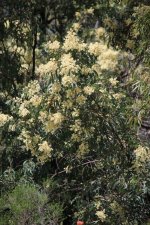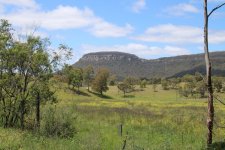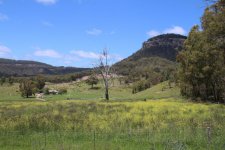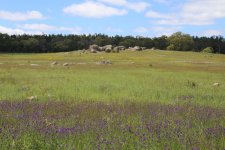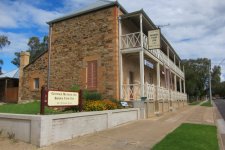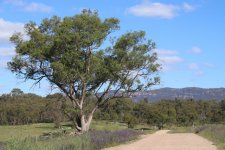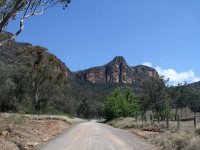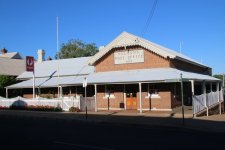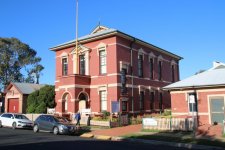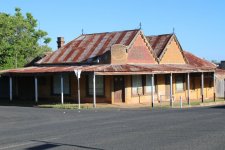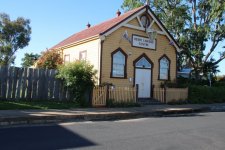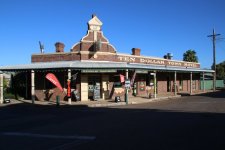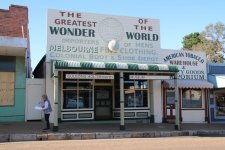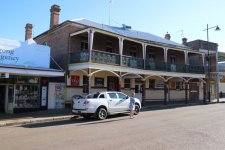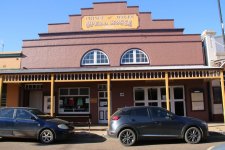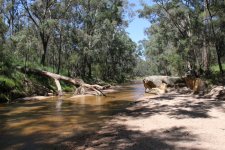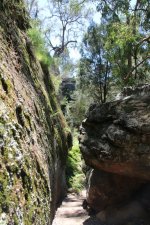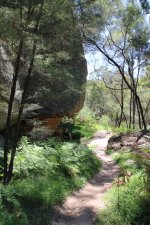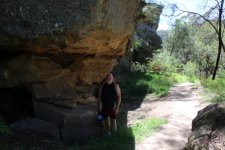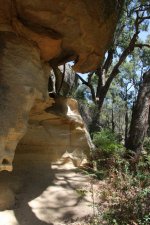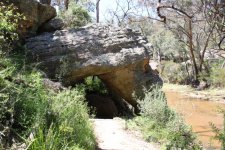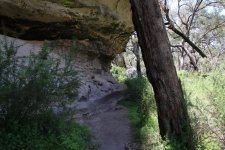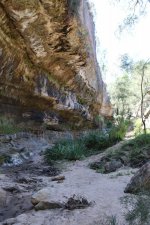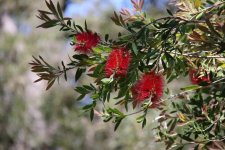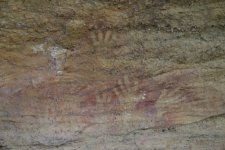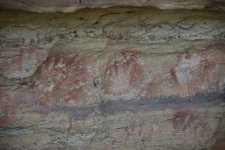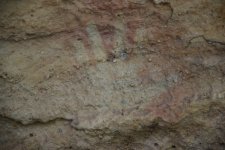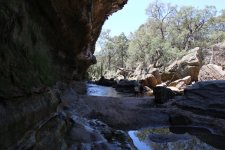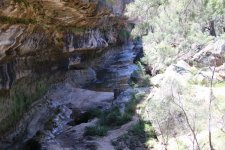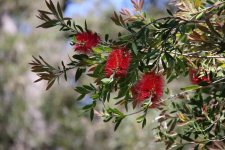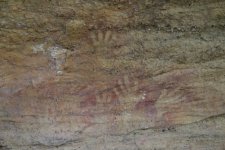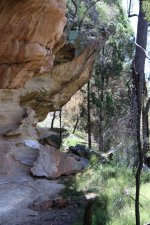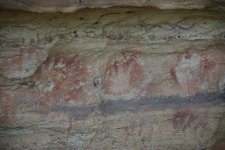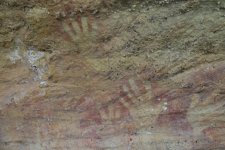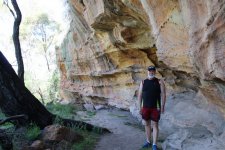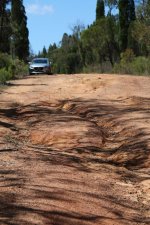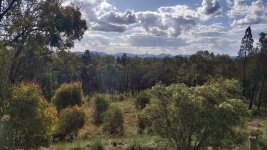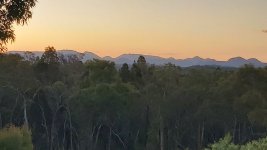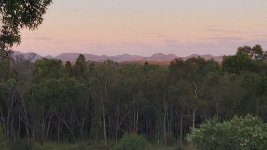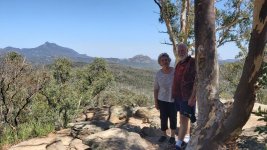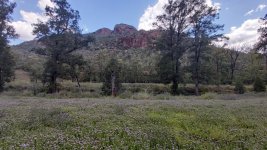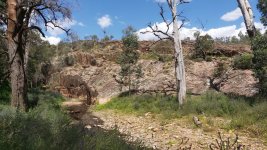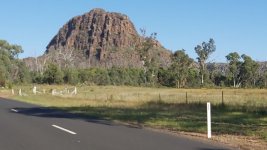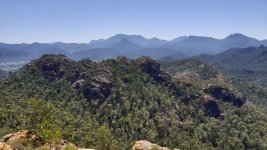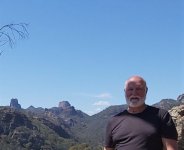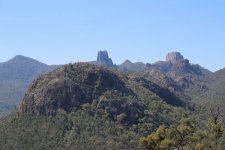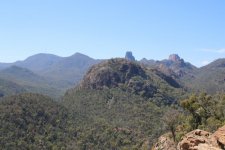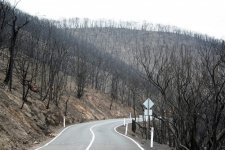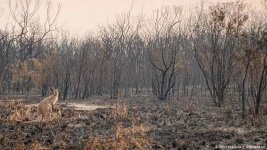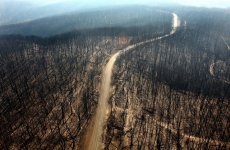We are staying at Bloodwood Ridge, an Airbnb owned by Sam, who is an arborist. Our apartment is at the back of the house with a deck that looks out on the Warrambungles. I couldn’t imagine a better view of them at dawn and sunset. Just stunning. He promotes his business as having “a Billion star rating”
The four-hour driving circuit around the Warrambungles, to take them in from all angles, was deleted from the five options I had planned for the two days we are based here in Coonabarabran. No way will we spend more time in the car than walking through the bush.
Nevertheless, Ches wasn’t up to my 4-hour walks, so we decided on the Whitegum lookout, the Wambelong Nature walking track and Burbie Canyon walking track. These are both listed as being easy walks. There are a number of walking tracks that involve camping out overnight and taking in the massive sky show, however we decided some time ago, that those days are behind us. Actually, they are behind Ches. They were never my days. I slept on a banana lounge with a mattress, in the back of my panel van, the last time I camped out.
The Warrambungles is big sky country. It’s has such a clean and clear atmosphere that the Siding Springs Observatory is located on the highest peak. August is when the Wiradjuri to the south and the Kamilaroi here, used to conduct many of their male initiation ceremonies. The Emu is one of their creation spirits and their story tells of the Emu living in the sky as part of the Milky Way and coming to earth where he became flightless. The Emu in the Milky Way is not formed by the stars but is actually the dark space in the middle. In August, it is most visible and that is when the Emu lays its eggs.
Whitegum lookout is on the way into the park and at the top of the first high mountain looking down and across the valley. From the left you can see: Balougery Spire, Breadknife, Bress Peak, Cathedral Rock and Split Rock. Just stunning, and we sat and took in the tranquility … and the bird song. Birdsong and wildflowers were the theme for the day. Everywhere we went there were carpets of wildflowers and bird song of great variety … and the buzzing of bees … and flies.
Every time we returned to the car, a dozen flies would join us for the drive to the next site. Faster than flying I guess.
We must have spent more than half an hour, just sitting and taking in the view as the sun rose high in the sky behind us. What a view.
We decided to visit the “Visitors Centre” to check on just how difficult the “Frans Horizon” is. Grade 3, moderate to steep. 3.6km, 2 hours return. The great thing about this walk is, that we get to see the Breadknife from side on. It is the plan for tomorrow, however Ches felt a need to check out just how “moderate to STEEP, it is” By the time we arrived at the Centre, it was closed for lunch. How lucky were we? Really lucky as it eventuated.
Just along the road from the Centre is the “Wambelong Nature track”. We passed a couple we had met at Whitegum, as they returned. I imagine that like us, they arrived at the carpark to find they were the only car, and that the usual signage and map board had been removed. Also like us, they had no idea where to find the track. We decided to go on to the Burbie Canyon walk and return later to the Information Centre and the Wambelong walk.
The Burbie Canyon walk was disappointing in comparison to yesterdays “The Drip” walk. There was barely any water in the river (creek) and the canyon section wasn’t much more than a couple of hundred meters long. It made up for it with masses of wildflowers, thousands of bees and myriad bird songs. Not a wallaby or kangaroo to be see, however lots of poo along the track … so they are there. Not an emu or koala either. It was the middle of the day however, with the temperature getting up to 27c (81F), and they were all probably taking shelter.
It was listed as 2km 40-minute walk. It took us well over an hour.
We drove back to the Information Centre and were advised that the Franz Horizon walk which is recorded as being “moderate to steep, 3.6km and 2 hours return” has around 1,000 steps and quite steep. Cheryl’s hips began to protest at the thought. O.K., best in the early morning, so we will start at 8.00am. Ches may not complete the journey but stop half way. We’ll see what the morrow brings we thought. Think again after what happened next.
We returned to the “Wambelong Nature track”. The guide had said that we should just follow the track along the river from the carpark and that it would involve crossing the river twice. Just a short 1.3km walk taking around 45 min. I’ve since read a dozen or so travelers reports on this walk, and they all agree … a leisurely stroll. I think they all took a short cut at the end, because a leisurely stroll, turned into a major climb and scramble over a massive rock dome and a descent that would be very difficult in wet weather.
The track began with a mowed path through the middle of a field of wildflowers. With the river out of sight to our right and a massive rock dome to our left, we suddenly entered a canyon with steep cliffs on both sides … yup, that’s what a canyon is. Beautifully scenic. At the river (creek at this time of the year), it was a precarious crossing stepping from stone to stone. Every meter or so, I stopped to offer Ches my hand for balance. She made it across dry. I decided that a photograph up the canyon, taken from the middle of the creek, would look particularly good. May balance since the 2007 stroke has never fully returned. I completed the walk with a soaked right foot.
It was a lovely walk along the river through fields of wildflowers and back across the creek on high concrete pylons this time. Serenaded by birds and bees all the way. Here we came across the far side of the rock dome. A sign explained that it is a good example of columnar jointing. Basically the rock is a mass of vertical columns all joined together which contrasts with most other rock formations that are horizontal in layers. It’s due to the lava cooling inward from the top.
At this point all we could see was the rock to our left, a field of flowers ahead and the road we had driven in on to our right. I think 99.9% of people then follow the road around to the picnic/car park. I chose to hug the cliff and found a track with steps going up onto the rock. Several hundred steps and ten minutes later, the track ended and all I could see was fluorescent yellow track markers nailed to the rock face. We clambered up to the top of the rock. From here we had distant views of the Whitegum lookout and the Breadknife. As I filmed, Ches suggested I look behind me. There, towering over us was Split Rock.
We continued over the top of the rock to the canyon where we had started. From here it was a fairly steep decent on very smooth rock to the bottom. Over an hour, and an experience that caused alarm for Ches as she contemplated tomorrows proposed walk that involves 1,000 steps on a 3.6km, 2 hour track.
While at Whitegum lookout, people had told us about “Donna the Astronomer”. She runs Milroy Observatory, with nightly small group experiences. Star Gazing. We had sent a text requesting a booking for either tonight or tomorrow night. Phone service in the park is intermittent, so it wasn’t till we exited the park that we received a reply confirming it for Wednesday night.
That settled it; an early start tomorrow for the Frans Horizon walk, an afternoon at home, out for dinner and then star gazing.

